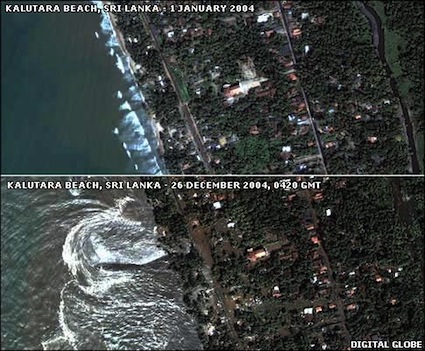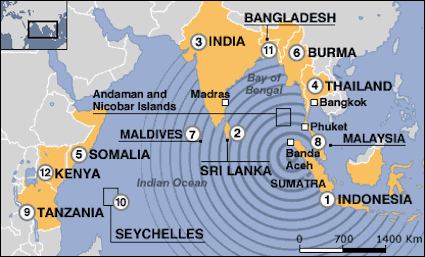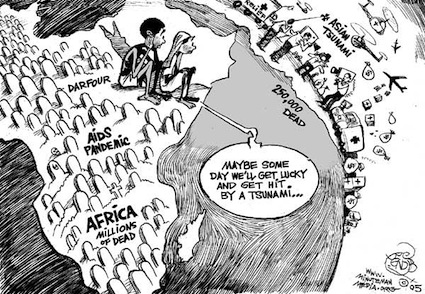On 26 December 2009, we mark the fifth anniversary of the Indian Ocean Tsunami, one of the biggest and deadliest disasters in history. It left a trail of destruction across South and Southeast Asia, killing over 225,000 and shattering the lives of millions more.
For many of us in the media and communication sectors, this was the biggest story of our lives. Because the killer waves hit numerous coastal locations in several countries, this disaster’s ‘Ground Zero’ was scattered far and wide. Not even the largest news organisations could see, hear and capture everything. Everyone had to choose.
And not just geographically, but thematically too, the tsunami’s impact was felt across sectors, issues and concerns. That provided both ample scope and many challenges for journalists, aid workers and others who rushed to the multiple scenes of disaster.

But there was a downside. Because the tsunami’s scale was so vast and its effects spread so wide, no single individual or organisation could comprehend the full picture for months. For many of us in the Indian Ocean rim, culturally unfamiliar with tsunamis, it was as if a Godzilla had stomped through our coasts. Grasping the full, strange phenomenon was hard.
Journalists, professionally trained to hastily produce ‘first drafts of history’, found it a bit like being close to a huge tapestry still being woven: we all absorbed parts of the unfolding complexity. We reported or analysed those elements that held our interest. But we were too close, and too overwhelmed, for much perspective.
Five years on, we can ‘zoom out’ more easily to see the bigger picture. When I do, one overarching factor stands out as the most important and lasting lesson of the tsunami: the need for better governance.
The absence of good governance was at the root of most major stories about the tsunami. It cut across every level in our societies — politics, public institutions, corporate sector, humanitarian agencies, academia and civil society.

A bagful of lessons
This certainly was the case with three facets of the big story that interested and engaged me for many months.
Early warning: It took a while for the tsunami waves, traversing the Indian Ocean at the speed of a jetliner, to reach India, the Maldives, Sri Lanka and Thailand. Yet, in this age of instantaneous telecom and media messaging, coastal residents and holiday makers were caught completely unawares — there was no public warning in most locations. Institutional, technological and systemic bottlenecks combined to produce this monumental failure in communication.
In Sri Lanka, where I live, there was also an internal failure in sharing the breaking news. The tsunami progressively pounded the tear drop-shaped island for nearly four hours, starting on the eastern coast south at around 8.30 am local time, and then gradually spreading north, south and finally west. If only the rest of the island had been alerted soon after the first waves hit, rapid coastal evacuation could have saved many lives elsewhere.
But that simply didn’t happen, and over 40,000 lives were lost — that is nearly half the death toll of 30 years of our (recently ended) civil war packed into one miserable morning. It included some 2,000 killed in the worst railway accident in world history when tsunami waves rammed into a packed train in Peraliya, 95 km south of Colombo. We didn’t hear of any responsible official resigning or being sacked.
Aid deluge: Accountability, a cornerstone of good governance, has also been lacking during the prolonged recovery. Saturation coverage in the global media inspired a massive outpouring of public and private donations to help Asian survivors: between governments and private individuals, a total of US$ 12 billion was pledged (though not all of it was actually paid up). As months passed, we heard many survivor complaints and media reports about neglect, discrimination, mismanagement, waste, excessive bureaucracy and corruption.

No affected country had a perfect record, although some handled the recovery better than others. On the first anniversary, the International Federation of Red Cross and Red Crescent Societies (IFRC) issued a report that documented how, flush with unprecedented funds, many aid agencies wasted tsunami money by failing to consult survivors, the United Nations or other relief groups. Three years on, Transparency International said its investigations revealed a gap between the amounts disbursed by foreign aid agencies and what has been spent on relief and recovery projects in Sri Lanka. Over US$500 million in tsunami aid had gone “missing”, the anti-corruption group said. (The figure was disputed by the government.)
Green lessons: In a widely published essay on rebuilding after the tsunami, author, diver and long time resident of Sri Lanka Sir Arthur C Clarke declared: “Nature has spoken loud and clear, and we ignore her at our peril.” He referred to wide-spread coral mining, shrimp farming and unplanned tourism development which made Sri Lanka’s coasts more vulnerable to erosion and tsunamis.
In fact, a few months before the tsunami, Lankan journalist Dilrukshi Handunnetti had written an investigative story on how coastal zone management laws and regulations were being openly flouted by developers. She cautioned that it was a ‘disaster waiting to happen’.
“But little did anyone realise the price coastal communities would have to pay for the greed of a few dozen developers,” she said after the disaster, when interviewed on a South Asian documentary film that I scripted.
Governance as lubricant
Laws, regulations and institutions are necessary, but not sufficient, for good governance. Other ingredients needed to bake that ‘cake’ well include the right to information, adequate public consultation and transparency in decisions and spending. These apply equally to governments, aid agencies and UN organisations.
Foresight is uncommon, but what is the excuse for not being wise in hindsight? For example, Sri Lanka’s new disaster law, adopted within months of the tsunami, has been criticised for its many deficiencies. As Dr Rohan Samarajiva, independent academic and a former telecom regulator, asked at the time: “The question is whether our people will have a few more minutes of warning and a little more knowledge on how to save their lives and those of their loved ones the next time. It may work; we have to hope that it will.”
Four years later, he still remains concerned. “A new disaster act may be a good way to commemorate the 5th anniversary of the tsunami,” he wrote in his organization LIRNEasia’s blog a few weeks ago.
The 2004 tsunami and aftermath underlined the crucial role of good governance in coping with disasters and other humanitarian emergencies. Mega bucks, massive infrastructure and high tech systems alone cannot ensure public safety or create resilience: good governance is the vital ‘lubricant’ that makes everything work well. Without it, we risk slipping back into business as usual, continuing our apathy, greed and short-termism.
This isn’t just a history lesson. As the world prepares for multiple, sustained impacts of global climate change, good governance can be a key plank in how we cope — that is, climate adaptation.
President Mohamed Nasheed, the first democratically elected leader of the Maldives — one of the frontline states already experiencing climate impacts — is emphatic about it. He told me in a recent interview: “Traditionally, we’ve always thought that adaptation represents physical structures –revetments, embankments, breakwaters, etc. But the most important adaptation issue is good governance and, therefore, consolidating democracy is very important for adaptation.”
He added: “When climate changes, and when you start feeling the actual impacts of it, you will be wasting all the resources without a proper governance system.”
As we bow our heads in memory of all who perished and suffered in the tsunami, the words of Spanish philosopher and poet George Santayana reverberate in my mind: “Those who cannot learn from history are doomed to repeat it.”
Science writer Nalaka Gunawardene heads the non-profit foundation TVE Asia Pacific, and initiated Children of Tsunami media project that tracked survivor recovery stories in the four hardest hit countries for one year. He blogs at http://movingimages.wordpress.com.
